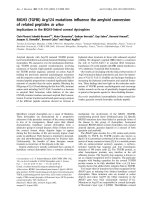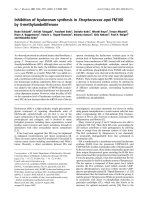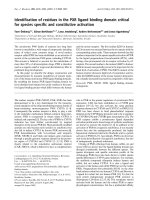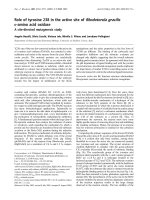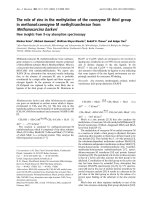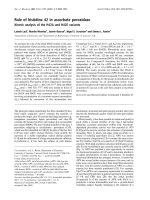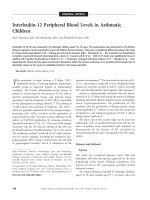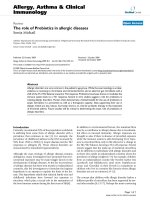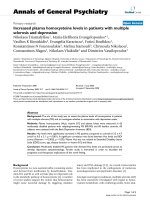Báo cáo y học: "Interleukin-12 Peripheral Blood Levels in Asthmatic Children" pptx
Bạn đang xem bản rút gọn của tài liệu. Xem và tải ngay bản đầy đủ của tài liệu tại đây (179.54 KB, 6 trang )
ORIGINAL ARTICLE
Interleukin-12 Peripheral Blood Levels in Asthmatic
Children
Ruth Soferman, MD, Idit Rosenzwig, MD, and Elizabeth Fireman, PhD
Interleukin-12 (IL-12) was measured in 45 asthmatic children aged 3 to 16 years. The assessments were performed on 20 children
during an episode of acute exacerbation and on 25 children during remission. There was no significant difference between the mean
IL-12 level during exacerbation (1.63 6 2.08 pg/mL) and during remission (0.88 6 0.56 pg/mL) (p 5 .83). A positive, but insignificant,
correlation was found between forced expiratory volume in 1 second and IL-12 (p 5 .634). IL-12 levels were significantly lower in
children with a positive family history of asthma (1.13 6 1.78 pg/mL) compared with those without (1.31 6 1.06 pg/mL) (p , .012),
supporting the theory that the gene–environment interactions affect the immune responses. IL-12 peripheral blood levels had no
detectable impact on the course of established asthma in the study population.
Key words: asthma, family history, IL-12
T
he prevalence of atopic asthma, a T helper (Th)2-
dependent disease, is reaching epidemic proportions,
possibly owing to improved hygiene in industrialized
countries.
1
The chronic inflammation of the airways in
asthma is characterized by the presence of Th2 cells in
sputum, bronchoalveolar lavage, and mucosal biopsy
specimens,
2
and the dominance of Th2 cells is responsible
for the pathogenesis of allergic diseases.
3–6
The priming of
T cells requires the activation of dendritic cells (DCs),
7
which are generally considered to be the principal antigen-
presenting cells (APCs) involved in the generation of
polarized effector cells.
4
DCs have a major influence on the
pattern of Th1/Th2 polarization by releasing cytokines,
especially interleukin-12 (IL-12).
5
The route of the antigen
encounter with the DC and the subtype of the APC can
profoundly influence Th differentiation.
7
IL-12, the critical
Th1-polarizing cytokine
8
produced by DCs after stimula-
tion by various antigens, including the endotoxin lipo-
polysaccharide (LPS), which is derived from the cell walls
of gram-negative bacteria
9
and it is ubiquitous in the
domestic environment.
10
The functional active form of IL-
12 is a heterodimer composed of two disulphide-linked
chains, p35 and p40, secreted by APCs
11
and by activated
Th1 cells; this heterodimer downregulates Th2 responses.
12
Studies in asthma models concluded that the admin-
istration of IL-12 before and during the period of allergen
challenge prevented allergen-induced airway eosinophilia,
airway hyperresponsiveness, the production of Th2
cytokines, and the production of allergen-specific serum
immunoglobulin E,
13
whereas it increased the production
of interferon-c and enhanced apoptosis of CD4
+
T cells in
allergic airway infiltrates.
14
The main aim of the current study was to assess the
relationship of IL-12 peripheral blood levels and the two
states of asthma, acute exacerbation and remission, as
demonstrated by the kinetics of DC activation by
environmental stimuli and, consequently, Th1/Th2 polar-
ization.
Patients and Methods
Patients
The study was conducted between April 2004 and
September 2005 after having been approved by the local
institutional review board (Helsinki Committee). The
parents of all of the participants provided written
informed consent.
The study population included 45 asthmatic children,
aged 3 to 16 years (median age 9.5 6 3.4 years), who were
Ruth Soferman: Pediatric Pulmonology Unit; Idit Rosenzwig:
Department of Pediatrics, Dana Children’s Hospital; and Elizabeth
Fireman: Laboratory of Pulmonary and Allergic Diseases, Tel Aviv
Sourasky Medical Center, Sackler Faculty of Medicine, Tel Aviv
University, Tel Aviv, Israel.
Correspondence to: Dr. Ruth Soferman, Pediatric Pulmonology Unit,
Dana Children’s Hospital, Tel Aviv Sourasky Medical Center, 6
Weizman Street, Tel Aviv 64239, Israel; e-mail:
DOI 10.2310/7480.2007.00010
128 Allergy, Asthma, and Clinical Immunology, Vol 3, No 4 (Winter), 2007: pp 128–133
recruited from the pediatric emergency department and
the pediatric pulmonology outpatient clinic. The inclusion
criteria were a diagnosis of asthma prior to study entry
confirmed by a pediatric pulmonologist and being treated
by inhaled corticosteroids for at least the two previous
months. The exclusion criteria were evidence of pneumo-
nia on the chest radiograph, fever, already being treated by
rescue medication (b
2
agonists and systemic steroids), and
having a chronic or acute illness other than asthma.
The participants were divided into two groups. Group
A consisted of 20 children who were recruited when they
arrived to the emergency department or to the outpatient
clinic during an acute exacerbation of asthma. Group B
included 25 asthmatic children who visited the outpatient
clinic for a regular follow-up evaluation and were in
remission.
The demographic information on the participants is
presented in Table 1.
Respiratory Symptoms and Asthma
In the study children $ 6 years of age, diagnosis of asthma
prior to recruitment was by clinical parameters and by
demonstrating bronchial hyperreactivity in pulmonary
function tests with a provocation by either exercise or
the adenosine test. Children younger than 6 years were
diagnosed by clinical parameters, including a history of
recurrent episodes of coughing, wheezing, and breath-
lessness that were relieved by bronchodilators and steroids.
The following data were collected for each patient:
respiratory symptoms throughout the 2 months prior to
the current presentation, the regular treatment regimen
during the past few months, a family history of asthma and
other diseases, smoking habits of family members, and the
presence of pets at home. A comprehensive physical
examination included the measurement and recording of
weight, height, respiratory rate, heart rate, and oxygen
saturation. Respiratory symptoms were evaluated accord-
ing to respiratory rate, respiratory chest recession,
auscultatory breath sounds, and general condition. Acute
exacerbation was defined by the presence of coughing,
tachypnea according to age,
15
respiratory muscle retrac-
tions, and auscultatory findings of wheezing with pro-
longed expiration. Remission was defined when the child
was free of cough for at least 2 weeks, the respiratory rate
was # 20 breaths/minute, there were no respiratory muscle
retractions, and normal breath sounds were heard on
auscultation.
Lung Function Tests
Spirometry was performed by a Vitalograph compact II
spirometer (Vitalograph Ltd., UK) in patients older than 6
years. The predicted results were analyzed according to
Polgar normative data.
16
IL-12 Measurements
IL-12 levels in serum samples were analyzed in duplicate
using a commercial kit: Quantikine high sensitivity human
IL-12 immunoassay (catalogue number HS120, R&D
Systems Inc., Minneapolis, MN). The Quantikine high-
sensitivity immunoassay kit uses an amplification system
in which the alkaline phosphatase reaction provides a
cofactor that activates a redox cycle leading to the
formation of a coloured product. The minimum detectable
dose of human IL-12 is typically less than 0.5 pg/mL. This
assay employs the quantitative sandwich enzyme immu-
noassay technique. A monoclonal antibody specific for IL-
12 has been precoated onto a microplate. Standards and
samples are pipetted into the wells, and any IL-12 present
is bound by the immobilized antibody. After washing away
any unbound substances, an enzyme-linked polyclonal
antibody specific for IL-12 is added to the wells. Following
Table 1. Demographic Data on the Two Groups of Study Children
Demographic Data Group A (n 5 20) Group B (n 5 25) p Value (Test)
Males/females 13/7 19/6 .42 (chi-square)
Median current age (yr) 8.2 6 3.1 10.5 6 3.3 .05 (Mann-Whitney)
Family history of asthma 12 (60%) 12 (48%) .42 (two-way ANOVA)
Passive smoking 8 (40%) 7 (28%) .4 (chi-square)
Pets at home 6 (30%) 8 (32%) .89 (chi-square)
Inhaled corticosteroids .52 (Fisher exact test)
Budesonide 10 (45%) 12 (48%)
Fluticasone 11 (55%) 13 (52%)
ANOVA 5 analysis of variance.
Soferman et al, Interleukin-12 Peripheral Blood Levels in Asthmatic Children 129
a wash to remove any unbound antibody-enzyme reagent,
a substrate solution is added to the wells. After an
incubation period, an amplifier solution is added to the
wells and colour develops in production to the amount of
IL-12 bound in the initial step. The colour development is
stopped, and the intensity of the colour is measured.
Statistical Methods
The assumption of normal distribution of continuous
parameters was examined using the Kolmogorov-Smirnov
and Wilk-Shapiro tests. Since the IL-12 levels were not
distributed normally, we also analyzed the reciprocal
transformation of this parameter to confirm the results.
Comparisons between the two groups of patients for
demographic parameters (gender, age, passive smoking,
family history of asthma, and pet at home) and other
factors (IL-12, forced expiratory volume in 1 second
[FEV
1
] measures) were performed using the t-test for
independent samples, the Mann-Whitney nonparametric
test, and the chi-square test, as applicable. In addition, a
two-way analysis of variance (ANOVA) was performed to
examine the association between each group’s family
history of asthma and IL-12 levels. Spearman nonpara-
metric correlation coefficients were calculated to study the
relationship between all continuous parameters and IL-12.
Significance was set at p 5 .05, and SPSS for Windows
software version 13.0 (SPSS Inc, Chicago, IL) was used for
the analysis.
Results
The patient population consisted of 45 children clinically
diagnosed as being asthmatic: 20 were studied during an
acute episode of asthma (group A) and 25 were studied
during a remission (group B). There were no significant
differences between the two study groups in terms of the
male to female ratio, pets at home, passive smoking, and
family history of asthma (see Table 1).
The median age of the children in group A (8.21 6 3.16
years) was significantly lower than the median age of the
children in group B (10.52 6 3.33, p , .025), but this
difference had no impact on the IL-12 analysis between
two groups.
The mean IL-12 level was 1.63 6 2.08 pg/mL (range
0.3–8.3 pg/mL) in group A and 0.88 6 0.56 pg/mL (range
0.4–3.2 pg/mL) in group B; the difference between the two
groups was not significant (t-test p 5 1.0 and Mann-
Whitney test p 5 .83). The IL-12 levels in both groups
were significantly lower in children with a positive family
history of asthma compared with children without. The
mean blood level of IL-12 was 1.13 6 1.78 pg/mL in
children with a family history of asthma and 1.31 6 1.06
pg/mL in children without a family history of asthma
(two-way ANOVA test p , .012) (Figure 1).
Plotting the related percent predicted values of FEV
1
to
IL-12 levels demonstrated a positive correlation between
FEV
1
and IL-12: higher IL-12 levels were correlated to the
higher percent predicted values of FEV
1
(Figure 2). These
positive correlations did not, however, reach a level of
significance (Spearman correlation coefficient, p 5 .634).
Discussion
The findings of this study demonstrated that there were no
significant differences between the mean peripheral blood
levels of IL-12 during asthma exacerbation and those
during remission. Thus, IL-12 peripheral blood levels do
not reflect the state of asthma. Although the children who
were tested during an acute attack were significantly
younger than the children who were tested while in
remission, Tomita and colleagues reported that age plays
no role in the production of IL-12.
17
We cannot provide
an explanation for the unexpected results, and further
clinical studies are needed to elucidate them.
Figure 1. Correlation of interleukin-12 levels to family history (Hx) of
asthma. p , .012 (two-way ANOVA test).
130 Allergy, Asthma, and Clinical Immunology, Volume 3, Number 4, 2007
All of the participants were treated by inhaled
corticosteroids. Since there are no publications of a direct
influence of inhaled corticosteroids on IL-12 blood levels,
we presume that the inhaled corticosteroids were not an
influencing factor on these results.
IL-12, a critical Th1 polarizing cytokine
8
and a
heterodimer
18
produced mainly by DCs and Th1 cells,
has been shown to have potent immune activity by
inducing Th1 responses, suppressing Th2 responses, and
enhancing apoptosis of CD4
+
T cells in allergic airways.
14
An exogenous form of IL-12 given to a mouse model
reduced established airway responses, such as eosinophilic
infiltration and airway hyperresponsiveness.
19
Endotoxins,
which are inflammatory LPS molecules derived from a
gram-negative bacteria wall, are ubiquitous in the indoor
environment,
20
and significantly associated with pets at
home.
21
A bimodal, dose-dependent relationship between
environmental exposure to LPS and the presence of
immune responses supports the hygiene theory by
demonstrating a preponderance of Th2 at low LPS
exposure and a preponderance of Th1 at high LPS
exposure.
22
Gereda and colleagues suggested that indoor
endotoxin exposure early in life may protect against
allergen sensitization.
23
Inhaled endotoxins trigger macro-
phages and other myeloid cells, including myeloid DCs,
through CD14, a LPS-binding protein, to release cytokines,
including IL-12.
24
IL-12 redirects the Th cells responses
toward the Th1 immune response.
25
Asthmatic patients
with severe airflow obstruction showed an impairment of
IL-12 production.
26
A study of peripheral blood mono-
nuclear cells showed that severe asthmatics had signifi-
cantly less positive staining for IL-12 after stimulation
with LPS compared with mild asthmatics and controls.
17
The genetic predisposition that determines the effect of
environmental endotoxins and allergic reactions and
the production of IL-12 was influenced by the polymorph-
ism in the CD14 gene.
27
In opposition to all of the above-
cited reports, the study of the national survey of
endotoxins in US housing demonstrated that household
endotoxin exposure is a significant risk factor for increased
asthma symptoms and wheezing.
28
Braun-Fahrlander and
colleagues claimed that exposure to endotoxins at school
age was an increased risk factor for asthma exacerba-
tions.
29
Figure 2. Interleukin-12 (IL-12) peripheral blood levels versus forced expiratory volume in 1 second percent (FEV
1
%) predicted values. There
were positive correlations between FEV
1
% predicted values and IL-12 peripheral blood levels, but they did not reach a level of significance (p 5 .6).
Soferman et al, Interleukin-12 Peripheral Blood Levels in Asthmatic Children 131
Blockade of IL-12 was recently demonstrated in an
animal model to have differential effects on allergic airway
inflammation, depending on the timing of the blockade.
Blocking IL-12 during the sensitization process aggravated
the subsequent development of allergic airway inflamma-
tion, whereas neutralization of IL-12 during the challenge
phase in previously sensitized mice abolished eosinophilic
airway inflammation.
30
The significantly lower mean level of IL-12 in children
with a positive family history of asthma compared with the
higher mean level in children without a positive family
history supports the theory that the gene–environment
interactions affect the immune responses.
31
Moreover,
higher IL-12 levels correlated with higher FEV
1
levels,
although not significantly so. In conclusion, we found no
relationship between IL-12 peripheral blood levels and the
course of established asthma in asthmatic children aged 3
to 16 years. The small cohort of children precludes our
arriving at any firm conclusions, so we recommend larger
clinical studies to validate our findings.
Acknowledgements
We thank Mr. Doron Comaneshter from the statistical
service of the Tel Aviv Sourasky Medical Center for his
help in statistical analysis and Mrs. Esther Eshkol for her
valuable assistance in revising the manuscript.
References
1. Umetsu DT, McIntire JJ, Akbari O, et al. Asthma: an epidemic of
dysregulated immunity. Nat Immunol 2002;3:715–20.
2. Mori A, Ogawa K, Kajiyama Y, et al. Th2-cell-mediated chemokine
synthesis is involved in allergic airway inflammation in mice. Int
Arch Allergy Immunol 2006;140:55S–8S.
3. Plummeridge MJ, Armstrong L, Birchall MA, Millar AB. Reduced
production of interleukin 12 by interferon-c primed alveolar
macrophages from atopic asthmatic subjects. Thorax 2000;55:842–
7.
4. Moser M, Murphy KM. Dendritic cell regulation of TH1-TH2
development. Nat Immunol 2000;1:199–205.
5. Prescott SL, Taylor A, King B, et al. Neonatal interleukin-12
capacity is associated with variation in allergen-specific immune
responses in the neonatal and post natal periods. Clin Exp Allergy
2003;33:566–72.
6. Lambrecht BN, De Veerman A, Coyle AJ, et al. Myeloid dendritic
cells induce Th2 responses to inhaled antigen, leading to
eosinophilic airway inflammation. J Clin Invest 2000;106:551–9.
7. Banchereau J, Steinman RM. Dendritic cells and the control of
immunity. Nature 1998;392:245–52.
8. Trinchieri G. Interleukin-12: a proinflammatory cytokine with
immunoregulatory functions that bridge innate resistance and
antigen-specific adaptive immunity. Annu Rev Immunol 1995;13:
251–76.
9. Milton DK, Johnson DK, Park JH. Environmental endotoxin
measurement: interference and sources of variation in the Limulus
assay of house dust. Am Ind Hyg Assoc J 1997;58:861–7.
10. Macatonia SE, Hosken NA, Litton M, et al. Dendritic cells produce
IL-12 and direct the development of Th1 cells from na
l
¨
ve CD4+ T
cells. J Immunol 1995;154:5071–9.
11. Shu U, Kiniwa M, Wu CY, et al. Activated T cells induce
inteleukin-12 production by monocytes via CD40-CD40 ligand
interaction. Eur J Immunol 1995;25:1125–8.
12. Jirapongsananuruk O, Leung DY. Clinical application of cytokines:
new direction in the therapy of atopic diseases. Annu Allergy
Asthma Immunol 1997;79:5–20.
13. Sur S, Lam J, Bouchard P, et al. Immunomodulatory effects of IL-
12 on allergic lung inflammation depend on timing of doses. J
Immunol 1996;157:4173–80.
14. Kodama T, Kuribayashi K, Nakamura H, et al. Role of interleukin-
12 in the regulation of CD4+ T cell apoptosis in a mouse model of
asthma. Clin Exp Immunol 2003;131:199–205.
15. Mathers LH, Frankel LR. Pediatric emergencies and resuscitation.
In: Behrman RE, Kliegman RM, Jenson HB, editors. Nelson
textbook of pediatrics. Philadelphia: Saunders; 2004. p. 280.
16. Quanjer PH, Borsboom GJ, Brunekreff B, et al. Spirometric
reference values for white European children and adolescents:
Polgar revisited. Pediatr Pulmonol 1995;19:135–42.
17. Tomita K, Lim S, Hanazawa T, et al. Attenuated production on
intracellular IL-10 and IL-12 in monocytes from patients with
severe asthma. Clin Immunol 2002;102:258–66.
18. Trinchieri G, Pflanz S, Kastelein RA. The IL-12 family of
heterodimeric cytokines: new players in the regulation of T cell
responses. Immunity 2003;19:641–4.
19. Kuribayashi K, Kodama T, Okamura H, et al. Effects of post
inhalation treatment with interleukin (IL)-12 on airway hyper-
reactivity, eosinophilia, and IL-18 receptor expression in mouse
model of asthma. Clin Exp Allergy 2002;32:641–9.
20. Thorne PS, Heederic D. Indoor bioacrosols: sources and
characteristics. In: Satthammer T, editor. Organic indoor air
pollutants: occurrence, measurement, evacuation. Weinheim
(Germany): Wiley – VCH; 1999. p. 275–88.
21. Park JH, Spiegelman DL, Gold DR, et al. Predictors of airborne
endotoxin in the home. Environ Health Perspect 2001;109:859–64.
22. Vercelli D. Learning from discrepancies: CD14 polymorphisms,
atopy and endotoxins switch. Clin Exp Allergy 2003;33:153–5.
23. Gereda JE, Leung DY, Thatayatikom A, et al. Relation between
house dust endotoxin exposure, type 1 T-cell development, and
allergen sensitisation in infants at high risk of asthma. Lancet 2000;
355:1680–3.
24. Tobias PS, Tapping RI, Gegner JA. Endotoxin interactions with
lipopolysaccharide-responsive cells. Clin Infect Dis 1999;28:476–
81.
25. Manetti R, Parronchi P, Giudizi MG, et al. Natural killer cell
stimulatory factor (interleukin 12 [IL-12]) induces T helper type 1
(Th1)-specific immune responses and inhibits the development of
IL-4 producing Th cells. J Exp Med 1993;117:1199–204.
26. Naseer T, Minshall EM, Leung DY, et al. Expression of IL-12 and
IL-13 mRNA in asthma and their modulation response to steroid
therapy. Am J Respir Crit Care Med 1997;155:845–51.
27. Simpson A, John SL, Jury F, et al. Endotoxin exposure, CD14, and
allergic disease. An interaction between genes and the environ-
ment. Am J Respir Crit Care Med 2006;174:386–92.
132 Allergy, Asthma, and Clinical Immunology, Volume 3, Number 4, 2007
28. Thorne PS, Kulhankova K, Yin M, et al. Endotoxin exposure is a
risk factor for asthma. The national survey of endotoxins in United
States housing. Am J Respir Crit Care Med 2005;172:1371–7.
29. Braun-Fahrlander C, Riedler J, Herz U, et al. Environmental
exposure to endotoxins and its relation to asthma in school-age
children. N Engl J Med 2002;347:869–77.
30. Meyts I, Hellings PW, Hens G, et al. IL-12 contribute to allergen-
induced airway inflammation in experimental asthma. J Immunol
2006;177:6460–70.
31. Hoffjan S, Nicolae D, Ostrovnaya I, et al. Gene-environment
interaction effects on the development of immune responses in the
1st year of life. Am J Genet 2005;76:696–704.
Soferman et al, Interleukin-12 Peripheral Blood Levels in Asthmatic Children 133

